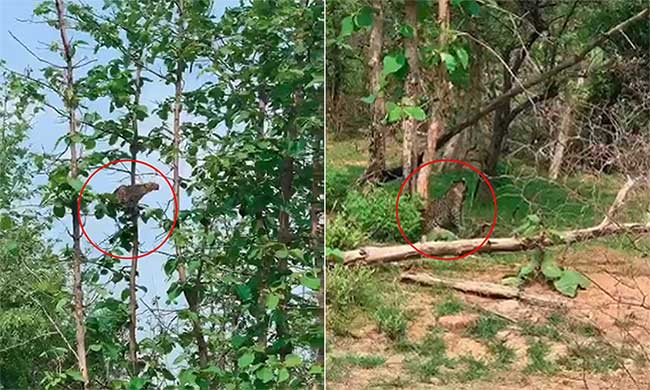A dramatic scene captures the daring leap of a leopard from one tree to another, followed by a tumble to the ground.
Leopards are known for their exceptional climbing skills, which is evident as they become the “predators” of tree-dwelling animals such as monkeys and gibbons.
In a thrilling clip recorded at the Panna Tiger Reserve, located in the heart of the Madhya Pradesh forests in India, a leopard is seen stalking its prey by leaping across treetops.
According to the person who filmed the clip, the leopard was lying in wait for a young monkey in a nearby treetop. Before making its leap, it spent several minutes perched on a branch, intently observing its target.
As it executed the jump, things did not go as the leopard had hoped; it unexpectedly missed the treetop, lost its balance, and fell to the ground from a height of nearly 30 meters.
At first glance, it seemed the leopard had failed and left empty-handed. However, upon closer inspection, it became clear that a monkey was lying motionless in its jaws. It turns out the leopard did not miss its target and quickly subdued its prey in an instant.
The leopard is one of the most successful predator species due to its remarkable adaptability.

Leopard tumbles after a “branch-hopping” leap to catch a young monkey
The leopard (Panthera pardus), also known as “leopard” in English, is one of the five big cat species in the Panthera genus found in Africa and Asia. They measure between 1 to nearly 2 meters in length and weigh between 30 to 90 kg. Females are typically about two-thirds the size of males.
Leopards have the largest distribution among all wild cat species, appearing widely in Africa as well as eastern and southern Asia, although their populations have shown a declining trend and are fragmented outside sub-Saharan Africa.
In the wild, despite being powerful predators, they often compete for food and shelter with other predators such as tigers, lions, cheetahs, spotted hyenas, and even African wild dogs. These animals can steal a leopard’s catch, kill the young, or even take down adult leopards.
As a result, leopards survive by hunting a variety of prey and trying to avoid areas frequented by larger carnivores. They can also actively retreat to trees when threatened by direct attacks from other large predators, but on the other hand, they can also kill or prey upon competing rivals.
Leopards also have a remarkable ability to adapt to their habitats, primarily associated with savannah grasslands and tropical forests. Leopard populations often thrive anywhere within their range, in grasslands, open forests, and riparian woodlands that are largely undisturbed.
In the Russian Far East, they inhabit temperate coniferous forests where winter temperatures can drop as low as -25 °C (-13 °F). They also adapt very well in some of the world’s wettest tropical forests and even at the edge of semi-arid deserts.


















































